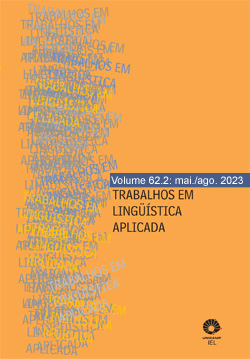Abstract
In this article, I elaborate on the awareness that, as a White man, my materiality takes part in a socioeconomic and political system that, regardless of personal merit, benefits me, unlike the vast majority of Black men and women, whose rights are marginalized. The questions I propose to answer are: in what way, despite being a White man, does translating the poetry of Black women produce affects that overcome these oppositions? Despite my own limitations, such a translation experience entails the possibility of a relationship described by monk and activist Thich Nhat Hanh (1991) as interbeing, which suggests the Buddhist concept of sunyata, meaning “emptiness of inherent existence” (CARLUCCI, 2022). All beings, according to Mahayana Buddhist philosophy, are interconnected at a deeper level of (inter)existence in that, between the Self and the Other, despite all differences, they maintain an existential connection in which they affect one another. Here, I purposefully play with the sense of “affect” and “being affected by” to reflect on love, as invited by African American activist, anti-racist, teacher, and artist bell hooks (2000, whose writings on love reverberate the issues I intend to discuss.
References
WEBER, S. (2020). On being and belonging. In CURTIS, R. C. (Ed.) Belonging Through a Psychoanalytic Lens. New York: Routledge.
AMORIM, L. M. (2016). O drama e a alegria da tradução: Gwendolyn Brooks versando a vida em três poemas. Cadernos De Literatura Em Tradução, (16), 131-146. https://www.revistas.usp.br/clt/article/view/115282
BESNER, R. (2020). Where does a discussion of Buddhism belong in psychoanalysis? In CURTIS, R. C. (Ed.) Belonging Through a Psychoanalytic Lens. New York: Routledge.
BRUM, A. (1992). A Libertação do Sofrimento no Budismo Tibetano Gelugpa. Brasília: Teosófica.
CARLUCCI, B. (2022). Uma meditação sobre o continuum tradutório: tradução indireta, comparada e comentada de passagens do Bodhicaryavatara de Shantideva. Doctoral dissertation, Unicamp. Disponível em: https://www.iel.unicamp.br/node/995/Lingu%C3%ADstica%20Aplicada/2022
COLLINS, P. H. (1990). Black Feminist Thought: Knowledge, Counsciouness, Politics of Empowerment. Cambridge: Cambridge University Press.
DERRIDA, J. (1981). Positions. Translated and annotated by Alan Bass. University of Chicago Press.
HANH, T. N. (1991). Peace is every step: the path of mindfulness in everyday life. New York: Bantam books.
HOOKS, B. (2000). Everything about love: new visions. New York: William Morrow.
MOREIRA, M.; DIAS, T. (2017). “O que é o lugar de fala e como ele é aplicado no debate público”. Nexo Jornal, 16 jan. 2017. Disponível em: https://www.nexojornal.com.br/expresso/2017/01/15/O-que-%C3%A9-%E2%80%98lugar-de-fala%E2%80%99-e-como-ele-%C3%A9-aplicado-no-debate-p%C3%BAblico . Acesso em: 14 janeiro 2022.
MULLEN, H. (2014). Cores desinventadas: a poesia afro-americana de Harryette Mullen. Tradução, introdução e notas de Lauro Maia Amorim. São Paulo: Dobra Editorial.
RIBEIRO, D. (2019). Lugar de fala. São Paulo: Sueli Carneiro; Pólen.
SPIVAK, G. C. (1988). “Can the Subaltern Speak?" in NELSON, C; GROSSBERG, C. (Eds.) Marxism and the Interpretation of Culture. Basingstoke: Macmillan. 271–313.
STERN, D. N. (2004). The present moment in psychotherapy and everyday life. New York: W. W. Norton.SUNYATA. (2023). In: Encyclopedia Britannica. https://www.britannica.com/topic/sunyata.
WEBER, S. (2020). On being and belonging. In CURTIS, R. C. (Ed.) Belonging Through a Psychoanalytic Lens. New York: Routledge.

This work is licensed under a Creative Commons Attribution 4.0 International License.
Copyright (c) 2023 Lauro Maia Amorim


